Have you ever tried to pull on a chainsaw cord, but it simply wouldn’t release? Although this can be very confusing, there are really a few very straightforward explanations as to why the pull cord might not be working.
In this article, we’ll discuss all the reasons why a chainsaw becomes hard to pull with a spark plug-in, along with fixes to each problem!
Table of Contents
- Why Is My Chainsaw Pull Cord Hard to Pull?
- How to Fix a Chainsaw With Too Much Compression
- Maintaining Your Chainsaw
- FAQs (Frequently Asked Questions)
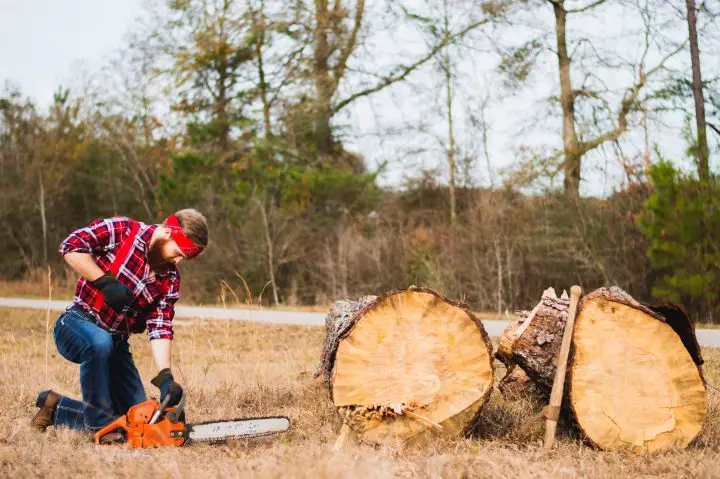
Why Is My Chainsaw Pull Cord Hard to Pull?
- Faulty rope
- The pully system is snagged or stuck
- Faulty starter assembly
- Broken starter string
- Damaged starter housing
- Damaged or seized engine
Breaking out your chainsaw for the season only to find it stuck is frustrating. Let’s now go over the most typical issues that make the chainsaw a hard pull, as well as quick fixes for each reason.
Faulty Rope
If your chainsaw isn’t pulling properly, you should check the rope first. The starter cord may become damaged, tangled, or coated with sap or other impurities that enter the starter assembly by hitchhiking and clogging the system.
I’ve seen a few chainsaw cords that were so matted with grass and other material that it was impossible to pull the line. This gunk may seriously damage a chainsaw since it gets down into the pully mechanism (more on that in a moment).
How to Fix Faulty Rope
Untwisting the rope or switching it out could take care of the issue. It is better to replace the rope with something of equivalent length and thickness if it is frayed or entirely broken.
Broken Pully System
The pulley system is crucial since it aids in the starter rope’s retraction. A damaged pulley system may result in a difficult or slow pull, or it may not pull at all.
How to Inspect Pully System
There are two key places to look:
- Check the pulley itself first because that is where the starter rope connects. The pulley wheel moves easily, right? Are there any obstructions in the pulley wheel?
- The pulley next moves to the spring and pawl. Is the spring free of rust or other obstructions and in operational condition?
The system must be under some tension for this to work because doing so leads the system as a whole to spin up. The chainsaw will not start and will either feel too easy to pull or too difficult to pull if the spring or pulley is destroyed.
How to Fix Pulley System
The best course of action is to fix or replace the particular pulley system component that is broken. Replacement will be the only choice unless the rope is just snagged on something inside or is sticky with sap.
Faulty Starter Assembly
Return to the starter assembly by following the starter rope through the pulley once more. When you pull on this, the starter assembly will rotate and start the system as a whole. Until you pull on your rope, this component will not revolve.
If you draw the rope once and nothing happens, you must wait for the rope to fully retract before pulling it once more. When you pull three or four times without getting any further and have to wait for the starter rope to retract once again, the starter assembly is malfunctioning.
How to Fix a Faulty Starter Assembly
The largest problem that starting systems may have is an oil shortage or the use of improper oil for the environment. The mechanism will seem slow to move and may not start properly if you try to start your chainsaw in cold weather with oil that is not designed to withstand those low temperatures.
It is crucial to replace the problematic part as soon as possible if it is one of the parts. If the rope is to blame, the best course of action may be to untwist it or move it so that it is no longer stuck.
Broken Starter Spring
The starting spring is crucial in supporting the starter assembly we previously discussed. Your starter rope should retract when it’s functioning properly. The spring might occasionally be fragile or weaken after repeated use. It’s possible for the spring to separate from the chainsaw after frequent use.
How to Fix a Broken Starter Spring
When the chainsaw is being pulled firmly, one of the first things to check is the spring. This is the easiest problem to solve and the most likely cause of difficulties.
Pull the starter rope to test the starter spring. If it is challenging to pull, evaluate how the spring is holding up. Take the spring in for replacement if it begins to sag. The entire starter assembly might need to be changed if the spring is totally destroyed. If the spring is broken, don’t try to manually start the chainsaw.
Damaged Starter Housing
Another frequent problem that can make the chainsaw difficult to draw is damage to the starter housing. The housing may crack, which could obstruct the rope’s course, or bits may fall inside and become twisted up and stuck in the starter and pulley.
How to Fix a Damaged Starter housing
It’s likely that you’ll have to entirely replace this. But if it’s only a little bit, you might be able to fix it with epoxy or tape.
Damaged or Seized Engine
The engine itself is the last and worst issue to have. The starter assembly might not be able to effectively pump the piston and start the engine if there has been any damage to the engine itself. The rope will also be challenging to pull or impossible to pull if the engine is completely seized.
Unfortunately, either of these problems may indicate that it’s best to abandon the project or take it to a professional. Without the necessary expertise, it is not a good idea to handle any tasks involving the piston or engine assembly itself. It might also be an excellent, low-risk chance to find out if the chainsaw is merely destined for the trash, though!
How to Fix a Chainsaw With Too Much Compression
Pull on the starter cable while removing the spark plug. You are on the correct track if the starter cord is simple to pull and no excess fuel squirts out of the spark plug hole.
It is a fair bet that the bearings are good and the cylinder and piston are in good shape when there is almost no resistance while pulling the chord with the spark plug out. If the spark plug is replaced but the cord is still extremely challenging to draw, the exhaust system needs to be checked out.
If the issue is one of “gradually becoming worse,” it’s likely that the exhaust has become a little choked and the fumes have nowhere to go. The solution to this issue should be to clean the exhaust passage.
To accomplish this, the muffler must be taken off, and the exhaust port must be examined for any potential accumulation of carbon build and other material deposits that will necessitate cautious cleaning. When placing instruments into the exhaust port, please use caution. The piston must be placed in such a way as to keep any foreign objects out of the cylinder.
Using any sharp metal object that could possibly damage the side of the piston or the cylinder is prohibited during this process. A stiff wire brush can be used to clean the muffler and remove any material buildup. Reinstall the exhaust after cleaning, and have the spark plug removed. Test the starter pulley by pulling it. Given that there is no compression, it ought to be simple.
Replace the spark plug next, and then try the starter cord once more. Always be sure you are installing a spark plug with the proper reach when replacing one. That indicates you should measure the spark plug’s thread length. Verify that it is appropriate for your machine.
Maintaining Your Chainsaw
Maintaining your chainsaw will help it last a long time and prevent you from having a chainsaw chain that is difficult to pull. Here are some methods and pointers to make your chainsaw as trouble-free as possible. Visit our Chainsaw Bar Upkeep and Maintenance guide for more information!
Proper Chainsaw Storage
It is important to store the chainsaw well. This will keep it from getting ruined or any of the parts rusting up:
- To prevent trips, keep the chainsaw above the ground.
- Keep the chainsaw away from any dampness or rain. The components could corrode and cease to function as a result of moisture.
- Avoid using the chainsaw in areas with a lot of fine dust or sawdust.
The ideal place to keep your chainsaw is a cold, dry area in your shop or garage to prevent anything from getting inside. This might lessen the possibility of something breaking or harming the chainsaw, keeping it from getting difficult to pull. A chainsaw cover might be a wise investment if you are in an area that is frequently humid or dusty.
Inspect the Chainsaw Often
Due to wear and tear and part failure, the chainsaw frequently begins to malfunction and becomes difficult to pull. You may lessen the possibility that you’ll have to deal with this kind of issue by doing proper maintenance.
There are a variety of reasons why you might have difficulty getting your chainsaw to behave if it starts to be difficult to pull. The simplest options can be ruled out by taking a brief glance at the parts of the starter system, like the rope, pulley, starter assembly, and spring.
If you’re new to using a chainsaw, you may be interested in reading our Chainsaw Tips for Beginners guide!
More chainsaw troubleshooting:
- How to Port a Chainsaw
- Are Chainsaw Bars Interchangeable
- How to Unflood a Chainsaw and Start It Once Flooded
FAQs (Frequently Asked Questions)
Why is my chainsaw pull cord hard to pull?
Your chainsaw pull cord may become hard to pull due to a faulty rope, the pully system being snagged or stuck, a faulty starter assembly, a broken starter string, a damaged starter housing, or a damaged or seized engine.
What causes a chainsaw to have too much compression?
Too much compression in chainsaws can be brought on by a variety of factors, including carbon buildup in the cylinder and piston, faulty gasoline, worn or old fuel, a bad needle bearing, an overworked starter spring, etc. You can resolve the problem by inspecting, checking, and replacing these.

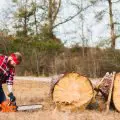
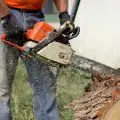
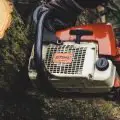
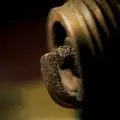
Great information thanks
new giantz chainsaw hasnt been used been sitting for a while take plug out pulls easy put plug back pulls hard no markings on piston fuel 40 to one hard to turn over dont know whats wrong